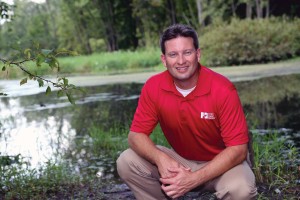
Adam Sharp’s boots are firmly on the ground when it comes to farming and protecting water: He is also a farmer in Fairfield County.
In summer 2014, Lake Erie and Grand Lake St. Marys, among others, again suffered harmful algal blooms. An ongoing problem in recent years, the blooms are mainly caused by excess phosphorus runoff, including fertilizer and manure from farms. And Ohio State University Extension — teaming with state agencies and Ohio farmers — is delivering crucial science-based educational programs to put new solutions to work.
As a latest example, OSU Extension specialists, tapping into ongoing research by their college, are developing and will provide the fertilizer certification training required by Ohio’s new nutrient management law, Senate Bill 150. Other efforts include teaching nutrient management sessions at Ohio’s yearly Conservation Tillage and Technology Conference, and updating nutrient recommendations — also based on college research — for growers of the state’s major crops.
In these and other programs, “Extension takes the scientific view,” said Greg LaBarge, OSU Extension agronomy field specialist. “We take the emotion out and develop solutions that meet both environmental and economic needs.”
Essentials
- Harmful algal blooms produce toxins that can sicken people and animals. Beach closings, expensive-to-treat or unsafe drinking water (as happened in summer 2014 in Toledo) and lost tour-ism revenue all can result.
- The drinking water for more than half the people in Ohio comes from lakes and other surface water at risk from harmful algal blooms.
- OSU Extension teams up on its water quality efforts with the Ohio Farm Bureau Federation, Ohio Department of Agriculture, U.S. Department of Agriculture, Ohio Department of Natural Resources, and Ohio Environmental Protection Agency, among others.
- OSU Extension specialists, for example, taught water-protecting practices to 900 participants — including 400 Certified Crop Advisers responsible for more than 3 million acres — at last year’s Conservation Tillage and Technology Conference. That acreage is equal to nearly a quarter of all the cropland in Ohio.
“Farmers are committed to protecting and improving our waters,” said Adam Sharp, vice president of public policy, Ohio Farm Bureau Federation. “But they need help through information-sharing, learning opportunities and education on the latest research and best nutrient management practices.
“OSU Extension is a key partner in providing these valuable services.”